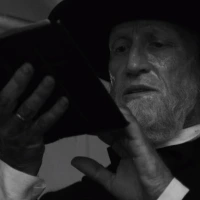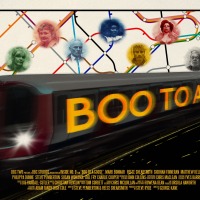 By Naomi Jacobs and Philip Purser-Hallard
By Naomi Jacobs and Philip Purser-Hallard
Obverse Books, out now
The Doctors’ encounters just prior to the First World War analysed…
As Naomi Jacobs and range editor Philip Purser-Hallard point out up front, this is a rather different Black Archive from those that have preceded it. I’ve commented before that the tie-in literature hasn’t always been analysed (or sometimes barely mentioned) in these tomes, but there’s no real option for this one. Whereas Rob Shearman’s Dalek took his Big Finish audio Jubilee as a starting point, and Rise of the Cybermen/The Age of Steel owed a debt for certain scenes to Marc Platt’s Spare Parts, this two parter from David Tennant’s second season set out to be a reworking of Paul Cornell’s New Adventure, and any discussion needs to, at the very least, cover the original text. (Not that there now is an exact original text: Cornell edited some of it for its BBC website iteration, and there’s now a BBC Books reprint.)
Once we get past the recital of the plot, a necessary set of notes on terminology, and the explanation for the change in Black Archive format, we begin with a brief description of the New Adventures, before Chapter 1 jumps straight in by pointing out that, far from being “pretty much a straight adaptation”, as Cornell has claimed, the two versions are very different. The initial chapter deals with the origins of the book, and its roots in the “hurt/comfort” genre as well as the alternate universe story – with Cornell’s debt to Peter David’s Star Trek: The Next Generation book Imzadi discussed (and a lovely theory floated as to why Cornell gave Joan Smith that particular first name!).
The reasons for the Doctor’s decision to “become human” are different in book and TV and are laid out here – with some of the logic lacunae in the latter version made clear – while the differences between his companions (the 26th century Benny in the book; 21st century Martha in the series) mean further changes in the way their scenes play out, as well as the triangle between Doctor-companion-Joan being affected by the way that the companion views the Doctor. The Aubertides and the Family of Blood are then contrasted, as are the versions of Tim.
 Chapter 2 deals with War and Peace, and the ways in which those themes are treated in both media. As the authors astutely point out, for all that the Seventh Doctor of the book was a master manipulator, he didn’t have the blood on his hands of the Tenth (OK yes that was later retconned by The Day of the Doctor, but critically at this point, the Tenth doesn’t know that). The way in which war is presented in the TV version comes in for some close examination, as does the idea of Tim being a coward (and this is rightly compared with the climax of the Ninth Doctor’s era) which goes through the First World War scenes right to the conclusion and the different colour poppies sported by the incarnations of Tim. There are a lot of well-made points in this chapter regarding the presentation of military thinking within Doctor Who (although not extended as far as the early version of the Twelfth Doctor).
Chapter 2 deals with War and Peace, and the ways in which those themes are treated in both media. As the authors astutely point out, for all that the Seventh Doctor of the book was a master manipulator, he didn’t have the blood on his hands of the Tenth (OK yes that was later retconned by The Day of the Doctor, but critically at this point, the Tenth doesn’t know that). The way in which war is presented in the TV version comes in for some close examination, as does the idea of Tim being a coward (and this is rightly compared with the climax of the Ninth Doctor’s era) which goes through the First World War scenes right to the conclusion and the different colour poppies sported by the incarnations of Tim. There are a lot of well-made points in this chapter regarding the presentation of military thinking within Doctor Who (although not extended as far as the early version of the Twelfth Doctor).
The third chapter focuses on school and family including a discussion of influences on the two media versions, including the 1983 serial Mawdryn Undead, the novel To Serve Them All My Days and Lindsay Anderson’s movie If… The fourth discusses Humanity and Divinity, with a look back at Cornell’s track record in this area, notably his first published Doctor Who novel Timewyrm: Revelation, and the Doctor’s actions within the story – notably his revenge on the Family. There’s an extended discussion of Martin Scorsese’s depiction of Jesus in The Last Temptation of Christ, based on the 1955 novel, and the concept of kenosis as it relates to the story. (Yes, the text does become quite scholarly at this stage.)
Chapter 5’s Hero and Superhero builds out of Cornell’s comment in the introduction to the reprint of Human Nature that “Superman II works every time”, but as with some of Cornell’s other assertions about his own work, this doesn’t appear to stand up to the forensic scrutiny from Jacobs and Purser-Hallard, who link things more to Joseph Campbell, and interpretations of his theories. At considerable length.
Appendices cover the character name differences between media, a discussion of a plot hole regarding the Family; links between Merlin and this story; and the tricky question of whether both adventures “happened” to the Doctor – getting into the sort of knots that Lance Parkin has had so much fun with in the AHistory series!
The conclusion does attempt to fend off potential criticisms of this volume by agreeing that it doesn’t discuss “human nature” (lower case) very much, having spent its time on other matters, and I’d suggest that there’s actually still space in the Black Archive for a second book on this two-parter that looks purely at the story as seen on screen.
Verdict: An erudite discussion of the themes underlying the two versions. 8/10
Paul Simpson












